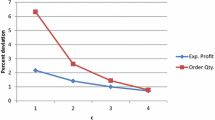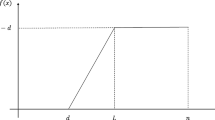Abstract
This paper concerns the multi-period newsvendor problem. In this problem, the decision maker has to decide the order quantity of an item in the subsequent period in which the demand is usually unknown. No statistical assumptions are made about the unknown demand. We adopt an online learning method from the field of prediction with expert advice to study the non-stationary newsvendor problem. We propose newsvendor strategies for both real-valued and integer order quantities. Taking the non-stationary strategies that can switch between different order quantities as benchmark, we prove that our proposed strategies can guarantee that the newsvendor’s cumulative gains are almost as large as those of the best switching strategies with not too many switches. Simple computational experiments are further performed to illustrate the effectiveness of our strategies.







Similar content being viewed by others
References
Alfares, H. K., & Elmorra, H. H. (2005). The distribution-free newsboy problem: Extension to the shortage penalty case. International Journal of Production Economics, 93–94, 465–477.
Azoury, K. S. (1985). Bayes solution to dynamic inventory models under unknown demand distribution. Management Science, 31(9), 1150–1160.
Ball, M., & Queyranne, M. (2009). Toward robust revenue management: Competitive analysis of online booking. Operational Research, 57(4), 950–963.
Bookbinder, J. H., & Lordahl, A. E. (1989). Estimation of inventory reorder level using the bootstrap statistical procedure. IIE Transactions, 21, 302–312.
Borodin, A., & El-Yaniv, R. (1998). Online computation and competitive analysis. Cambridge: Cambridge University Press.
Cesa-Bianchi, N., & Lugosi, G. (2006). Prediction, learning, and games. Cambridge: Cambridge University Press.
El-Yaniv, R. (1998). Competitive solutions for online financial problems. ACM Computing Surveys, 30, 28–69.
Gallego, G., & Moon, I. (1993). The distribution free newsboy problem: Review and extensions. Journal of the Operational Research Society, 44(8), 825–834.
Herbster, M., & Warmuth, M. K. (1998). Tracking the best expert. Machine Learning, 32, 151–178.
Heuvel, V. D., & Wagelmans, A. P. M. (2010). Worst case analysis for a general class of on-line lot-sizing heuristics. Operational Research, 58(1), 59–67.
Huh, W. T., Janakiraman, G., Muckstadt, J. A., & Rusmevichientong, P. (2009). An adaptive algorithm for finding the optimal base-stock policy in lost sales inventory systems with censored demand. Mathematics of Operations Research, 34(2), 397–416.
Huh, W. T., & Rusmevichientong, P. (2009). A nonparametric asymptotic analysis of inventory planning with censored demand. Mathematics of Operations Research, 34(1), 103–123.
Iglehart, D. L. (1964). The dynamic inventory problem with unknown demand distribution. Management Science, 10(3), 429–440.
Kalnishkan, Y., & Vyugin, M. V. (2008). The weak aggregating algorithm and weak mixability. Journal of Computer and System Sciences, 74(4), 1228–1244.
Karlin, A. R., Manasse, M. S., Rudolph, L., & Sleator, D. D. (1988). Competitive snoopy caching. Algorithmica, 3(1), 79–119.
Keisuke, M. (2006). The multi-period newsboy problem. European Journal of Operational Research, 171, 170–188.
Levina, T., Levin, Y., McGill, J., Nediak, M., & Vovk, V. (2010). Weak aggregating algorithm for the distribution-free perishable inventory problem. Operations Research Letters, 38(6), 516–521.
Liao, Y., Banerjee, A., & Yan, C. (2011). A distribution-free newsvendor model with balking and lost sales penalty. International Journal of Production Economics, 133, 224–227.
Liyanage, L. H., & Shanthikumar, J. G. (2005). A practical inventory control policy using operational statistics. Operations Research Letters, 33(4), 341–348.
Moon, I., & Choi, S. (1995). Distribution free newsboy problem with balking. Journal of the Operational Research Society, 46(4), 537–542.
Moon, I., & Choi, S. (1997). Distribution free procedures for make-to-order (MTO), make-in-advance (MIA), and composite policies. International Journal of Production Economics, 48(1), 21–28.
Moon, I., & Silver, E. A. (2000). The multi-item newsvendor problem with a budget constraint and fixed ordering costs. Journal of the Operational Research Society, 51(5), 602–608.
Scarf, H. (1958). A min-max solution of an inventory problem. In K. Arrow, S. Karlin, & H. Scarf (Eds.), Studies in the mathematical theory of Inventory and production (pp. 201–209). Palo Alto, CA: Stanford University Press.
Scarf, H. (1959). Bayes solution of the statistical inventory problem. Annals of Mathematical Statistics, 30(2), 490–508.
Scarf, H. (1960). Some remarks on Bayes solutions to the inventory problem. Naval Research Logistics, 7, 591–596.
Sleator, D., & Tarjan, R. (1985). Amortized efficiency of list update and paging rules. Communications of the ACM, 28(2), 202–208.
Vovk, V. (1999). Derandomizing stochastic prediction strategies. Machine Learning, 35, 247–282.
Wagner, M. R. (2010). Fully distribution-free profit maximization: The inventory management case. Mathematics of Operations Research, 35(4), 728–741.
Wagner, M. R. (2011). Online lot-sizing problems with ordering, holding and shortage costs. Operational Research Letters, 39(1), 144–149.
Acknowledgments
This research was supported by the National Natural Science Foundation of China (No. 71301029), the Humanities and Social Science Foundation of the Ministry of Education of China (No. 11YJC630255 and No. 13YJC630234), the National Social Science Foundation of China (No. 11&ZD156), and the Engineering and Physical Sciences Research Council of the UK (No. EP/F002998/1 and CEReS). Part of this work was done when the first author was visiting Rutgers Business School—Newark and New Brunswick as a PhD student. This author would like to thank Khrystyna Bochkay for her helpful suggestions that greatly improved the presentation. The authors are grateful to the reviewers for many useful comments (in particular, for pointing out a gap in the proof of Theorem 2). The computational experiments in Sect. 5 have been carried out using MATLAB.
Author information
Authors and Affiliations
Corresponding author
Rights and permissions
About this article
Cite this article
Zhang, Y., Vovk, V. & Zhang, W. Probability-free solutions to the non-stationary newsvendor problem. Ann Oper Res 223, 433–449 (2014). https://doi.org/10.1007/s10479-014-1620-8
Published:
Issue Date:
DOI: https://doi.org/10.1007/s10479-014-1620-8




